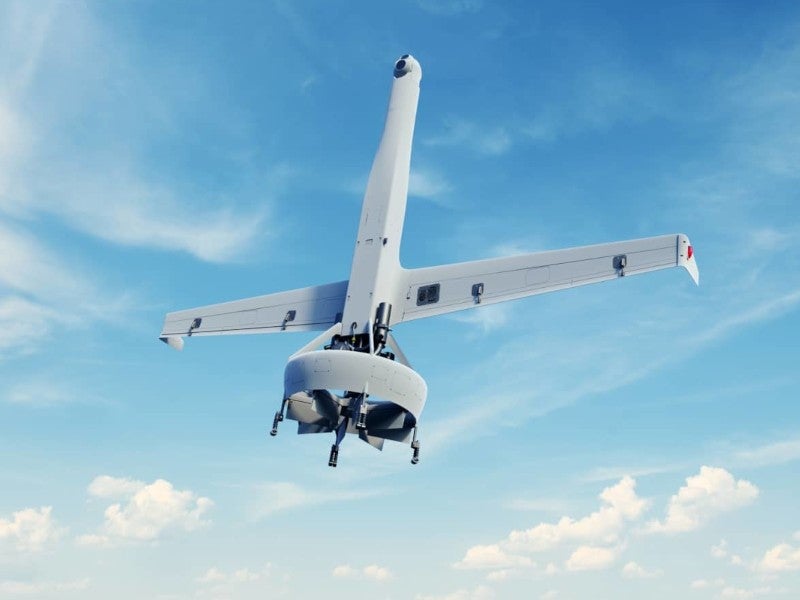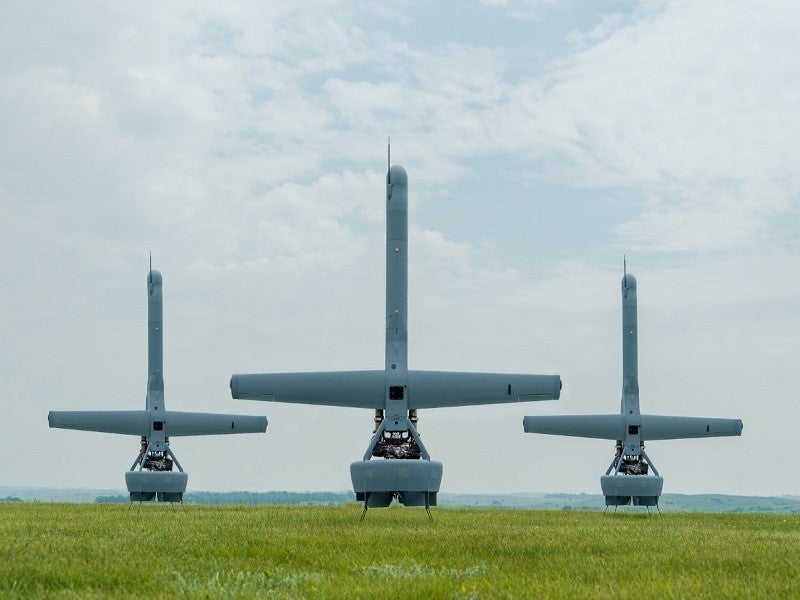The V-Bat is a vertical take-off and landing (VTOL) unmanned aerial vehicle (UAV) designed for runway-independent launch and recovery.
The UAV was originally developed by MLB Company, which was acquired by Martin UAV in 2015. Martin UAV was subsequently acquired by Shield AI.
The agile, compact, and lightweight V-BAT platform is engineered to carry out missions ranging from Group Two to Group Five.
The UAV can be deployed in a wide range of missions such as force protection, aerial patrol, search and detection of targets, small unit surveillance, shipboard operation, aerial mapping, urban monitoring, autonomous delivery and placement of payloads, and agricultural and wildlife surveillance.
It can be assembled by just two individuals in under 20 minutes, making it an ideal expeditionary system for rapid deployment and adaptable mission requirements.
V-Bat UAV design and features
The V-Bat VTOL aerial system features fixed wings and a slender fuselage. It incorporates a mechanically simple ducted fan lift system to provide control and lift for the UAV’s vertical flight, enhancing aerodynamic efficiency.
The UAV has a length of 9ft, a wingspan of 9.7ft, and a weight of 125lbs (fuel and payload). It has an endurance of ten hours and a payload capacity of 25lbs.
Featuring autonomous VTOL capabilities, the drone can be launched and recovered within a 3m x 3m area. It offers better situational awareness in urban and confined areas.
It can complete the hover-to-flight transition in under 15 seconds and has a service ceiling of 20,000ft.
It features a landing zone of 12ft by 12ft and can operate as a maritime UAS, offering fully automated flight operations around the clock.
The UAV is equipped with a patented ducted fan design that significantly enhances thrust by more than 80% at comparable engine power levels.
This innovation allows for take-off and landing using a single power plant while achieving an unparalleled payload mass fraction.
Furthermore, thrust vectoring provides the V-BAT with better control and stability, even in harsh weather.
The duct design enhances safety by eliminating operator safety zones, thereby expanding the tactical employment envelope.
V-Bat unmanned air vehicle development details
The V-Bat UAV was selected for the US Defense Advanced Research Projects Agency (DARPA) Precision Emplacement project in August 2010.
The USAF awarded a phase I contract for the development of the long endurance tail-sitter in September 2011. The DARPA Precision Emplacement project was completed in late September 2011.
The 12lb battery-equipped V-Bat, with a 1lb payload, completed its first flight in February 2012. The USAF awarded a Phase II Small Business Innovation Research contract to MLB, AAI Unmanned Aircraft Systems, and Brigham Young University (BYU) for the V-Bat UAV in August 2012.
AAI took responsibility for the development of the system design for low-rate initial production while BYU provided control algorithms and assisted flight trials.
Payloads and sensors onboard V-Bat UAV
The V-BAT can accommodate a variety of interchangeable and customisable payloads and sensors such as electrooptical/mid-wave infrared cameras, automatic identification systems, and artificial intelligence-based capabilities for land/maritime wide area search.
The payload features electro-optical and infrared sensors, as well as communications relays, enabling surveillance, detection, classification, and identification for all operational missions.
It is equipped with Cloud Cap’s lightweight, versatile TASE 150/200/400 Gimbal payload system that provides increased performance and endurance. The payload is stabilised in two axes.
The payload system consists of a global positioning system/inertial navigation system. An image processing technique is used for target tracking and scene steering.
It also includes advanced ViewPoint gimbal software to display video and command/control information. The payload can be optionally attached with a laser illuminator and a laser rangefinder.
The UAV is also fitted with a Canon 1-D camera and Tetracam’s Mini-MCA (Multiple Camera Array) multispectral camera to capture high-resolution, real-time imagery and video.
It can be optionally fitted with custom payloads, additional sensors, and long-range data links.
The vehicle is also equipped with an LOS FM data link to transmit command, control and video information up to a range of 35 miles.
V-Bat UAV propulsion and performance
The V-Bat VTOL UAV is powered by a 157cc, two-stroke engine that generates an output power of 13hp.
The engine uses Mogas 90 octane or higher 40:1 oil mix and has a fuel capacity of 20lbs.
The UAV can fly at a maximum speed of 90 knots and offers a range of 300 miles. It can operate at an altitude of 15,000ft and in wind speeds up to 25 knots.
Shield AI V-BAT variants
Shield AI announced the development of the Multi-Mission Tactical UAVS Increment 2 (Mi2) prototype project in collaboration with the Naval Air Warfare Center Aircraft Division (NAWCAD) in November 2021.
The company aims to deliver the full Mi2 prototype of its V-BAT UAV to the US government for testing and approval.
The Shield AI V-BAT variant for NAWCAD’s Mi2 programme features two built-in modules that enable communication across dual bands, boosting resilience in congested and contested environments.
Testing of V-BAT systems
In August 2023, Shield AI successfully conducted an autonomous teaming demonstration with three V-BAT systems.
Three V-BAT teams achieved a milestone in an autonomy initiative launched by the Department of the Air Force’s innovation arm, AFWERX.
The three teams executed an autonomous mission in collaboration with the Air Force Research Laboratory’s Sensors Directorate under the Strategic Funding Increase programme.
Shield AI demonstrated its Hivemind AI pilot technology by deploying a trio of V-BATs to oversee and examine simulated wildfires.
The coordinated team of multiple agents executed missions focused on detecting, identifying, locating, and reporting tasks in a contingency setting, showcasing its dual-use applications.
V-BAT UAV orders and deliveries
Aerospace and defence company Northrop Grumman in partnership with Shield AI was selected by the US Army to compete in Increment 2 of the Future Tactical Unmanned Aircraft System (FTUAS) programme in March 2023.
The FTUAS programme is aimed at replacing the venerable RQ-7B Shadow tactical UAV.
The team led by Northrop Grumman is responsible for defining the modular open-system architecture of an enhanced V-BAT aircraft, incorporating advanced surveillance and electronic warfare payloads.
In July 2024, Shield AI secured a $198.1m contract from the US Coast Guard to provide contractor-owned, contractor-operated intelligence, surveillance, and reconnaissance services using the V-BAT UAV.







